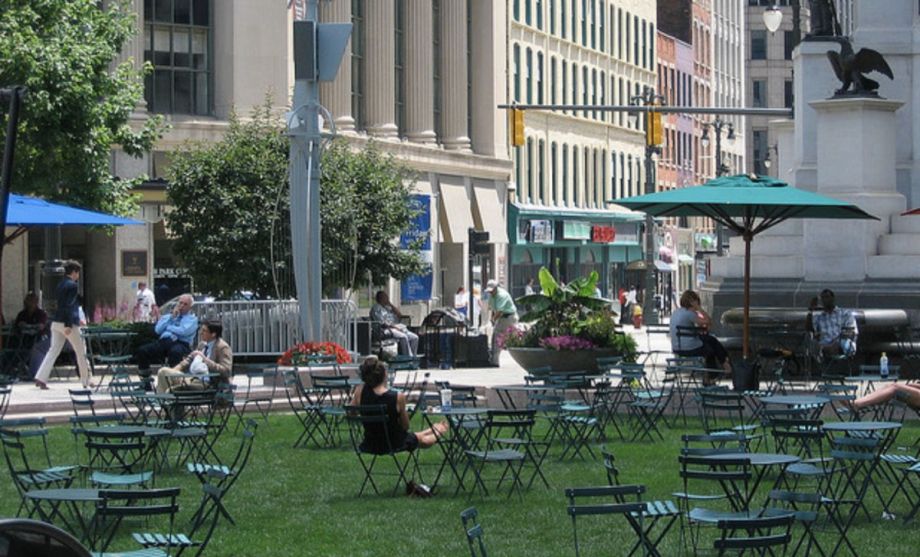This piece originally ran in The Transport Politic.
Just three weeks after a 9.3-mile light rail line down Woodward Avenue, the city’s central strip, Mayor Dave Bing revealed on Friday that he would allow a shorter link funded by a private group to move forward if it submitted an acceptable business plan within 90 days.
The project will have to be built right: Even at just 3.4 miles, the line could serve as a quick, reliable connector between the waterfront and the New Center, via Midtown. But that will only be possible if trains have their own lanes, run frequently and are funded with no negative effect on the city’s already under-financed bus system. There is evidence that those conditions will not be met. Yet the project’s design has yet to be completed — Detroit transportation advocates could still successfully fight for the appropriate implementation of this first stage of Woodward Light Rail.
But the circumstances in which the project’s reactivation has occurred speak to a continued dysfunction not only in Detroit but in American transportation politics in general.
The rail project was put on hold last month because of the sense that Detroit — already mired in debt — would be unable to afford the operations costs of the corridor (estimated at $10 million a year) without sacrificing bus service. Repeated plans for a regional transportation authority, and associated funding, have been in the air for decades. Only a plan that served the suburbs well would be acceptable, since they would have to agree to increase financing for transit. So Bing, Michigan Governor Rick Snyder and U.S. Transportation Secretary Ray LaHood agreed to refocus efforts and money on city-suburban improvements to the bus network.
The latest move is backtracking at its best. Seemingly overwhelmed by calls from influential congressmen and the executives of downtown businesses like Quicken, Penske, and Compuware — who have already lined up $80 million for a $125 million short version of the line (called M1-Rail, which was actually proposed in advance of the longer corridor) — the deal from last month will be amended. That is, if business leaders are able to find an effective way to cover the remainder of the capital costs and provide for the continued operations of the line, which they have said they could pay for through a tax-increment financing (TIF) district. They also want to take back the $25 million TIGER grant promised by LaHood in early 2010 and pulled back in December.
Why the sudden change in prospects for the line? Why weren’t these investors — willing to put up a surprising amount of money — consulted before their project was abandoned? What assurances do we have from the mayor and governor that suburban interests won’t be yet again frustrated by the fact that Detroit gets rail and they get rapid buses — and veto a regional transit authority? Where is the communication and where is the consistency in policymaking?
Just as we have seen with the Obama administration’s high-speed rail program, or New Jersey’s ARC rail tunnel, or a variety of maglev projects, this country specializes in spending years studying projects, then partially funding them, then effectively abandoning them. This results in years of delays and extra spending. I have been clear in the past that the Woodward rail line is a questionable priority for the region, but the move back and forth on decisions helps no one. Downtown Detroit’s leaders have been waiting patiently for the rail line, planning ahead around its development; were they forced to reconsider their options last month? Now what do they do?
There is nothing clear, after all, about the future of this project.
Nonetheless, the line does show some promise, because if Detroit is going to grow at all (it lost more than 230,000 people between 2000 and 2010), it will be in the small area bordered by the Chrysler and Lodge Freeways on the east and west, and by Grand Boulevard and the waterfront on the north and south — and that’s exactly the neighborhood the short light rail line is supposed to serve. In that area, within half a mile of the Woodward corridor, are already 123,000 jobs (here’s a map of employment density in the corridor) and about 20,000 residents, according to the U.S. Census. Most of the city’s major cultural institutions, including Wayne State University, sports stadiums and several casinos, are within walking distance. Connections will be possible not only with the existing bus lines and Amtrak but also with the new BRT services proposed by Snyder last month, meant to link Detroit with the suburbs and the airport via Michigan, Woodward and Gratiot avenues.
As I referenced at the start of the article, however, a light rail line within this area could be an appropriate addition to the transportation landscape of the city — or it could be the second coming of the much-maligned People Mover, which makes a quarter-mile-radius circle in one direction downtown. That system attracts few riders. But the Woodward corridor, serving real trip needs, could work — under certain conditions.
Light rail vehicles must be designed to run in their own lanes and be able to take advantage of traffic signal prioritization to ensure that they make the journey between destinations quickly. But the M1 group has been adamant that trains run next to the sidewalk in shared lanes to “boost tourism and redevelopment.” I was not informed that tourists and developers were particularly enamored of slow trains that have the propensity of being stuck in traffic.
Meanwhile, such a short corridor must feature trains running very frequently. While many of the riders will be residents commuting to and from work, a significant share is likely to be made up of people transferring from other transit modes and of people who drove into work and need a downtown circulator. For the latter groups, waiting more than five minutes for a train in the middle of the day would represent a significant impediment to using the system, as they have other options, such as walking or buses. But the tenuous nature of financing for transit in metropolitan Detroit suggests that it will not be easy to fund such services, even if a TIF district is established. Once it becomes clear that the light rail line hasn’t solved the city’s woes, can we be sure that the business lobby won’t switch its interests to funding parks or other amenities?
For the sake of the city’s bus system and its future BRT network, operations funding for the light rail project cannot be derived from expenditures meant to be devoted elsewhere, such as from the proposed regional transit authority, as Bing and Snyder have already made clear. Making it over this hurdle will be difficult.
Within ninety days, the city should make a very clear, final decision about its interests in the future of the Woodward corridor, giving the M1 group a definitive answer about the future of the light rail line. The rail project should be built only if it can be funded without affecting bus financing and provide excellent transit service downtown. No more dilly-dallying.

Yonah Freemark is a senior research associate in the Metropolitan Housing and Communities Policy Center at the Urban Institute, where he is the research director of the Land Use Lab at Urban. His research focuses on the intersection of land use, affordable housing, transportation, and governance.




_600_350_80_s_c1.JPEG)











